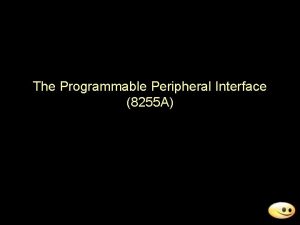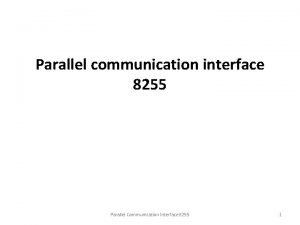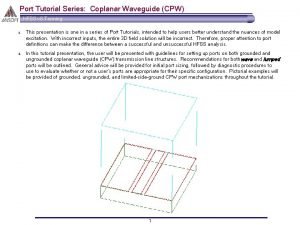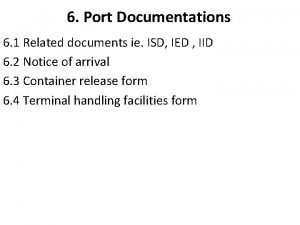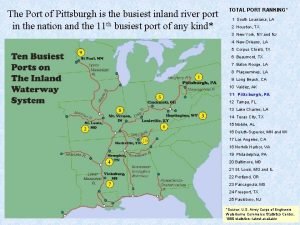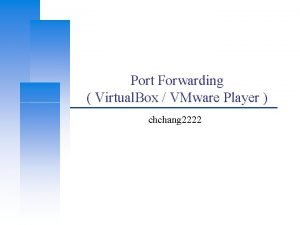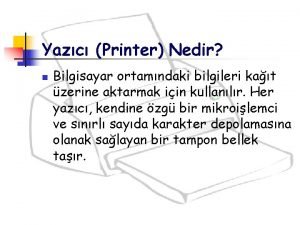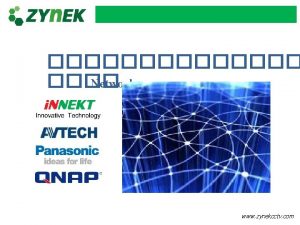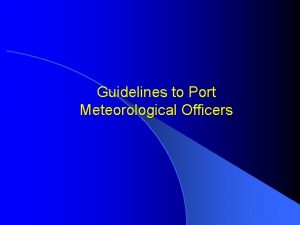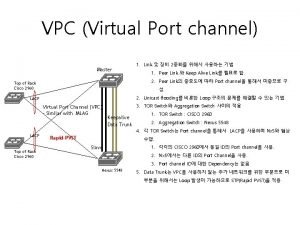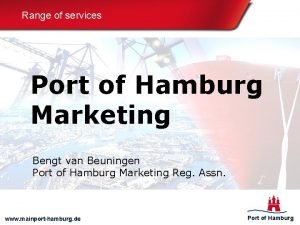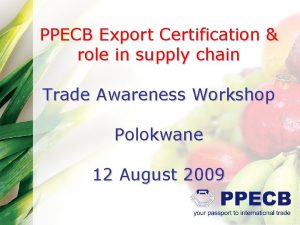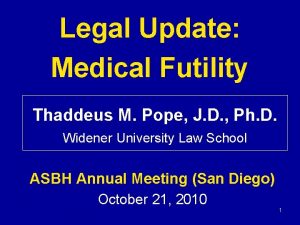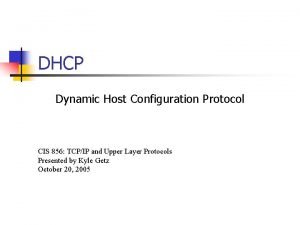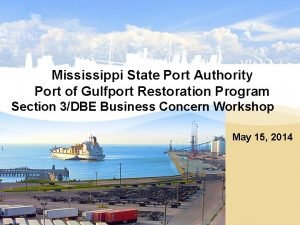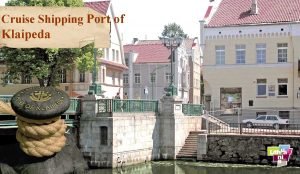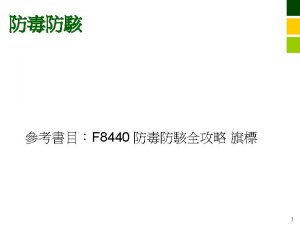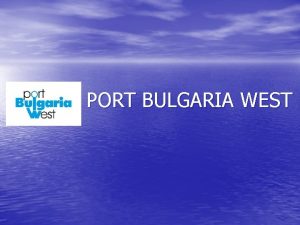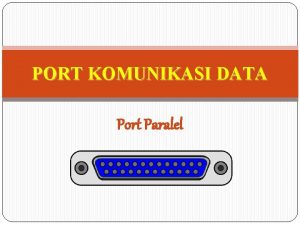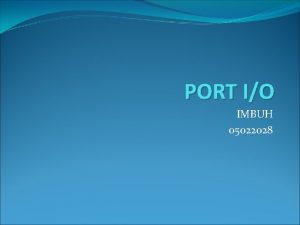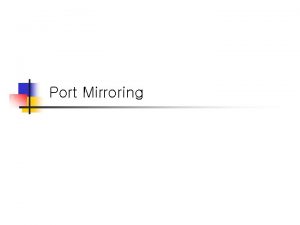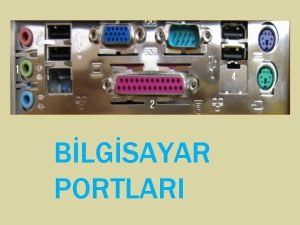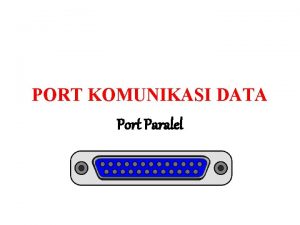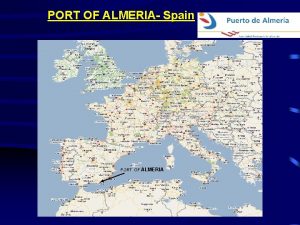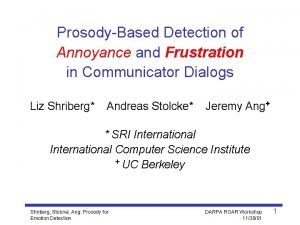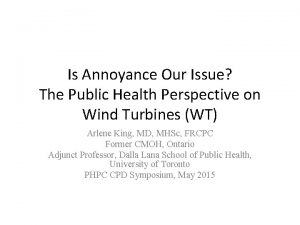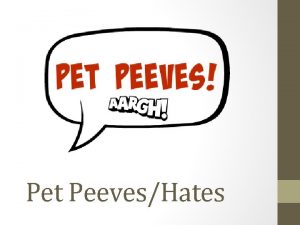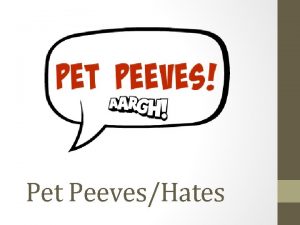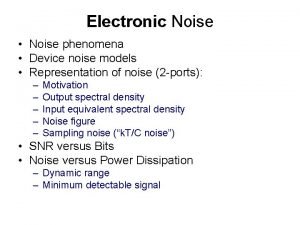Evaluation of noise annoyance of port related noise




























- Slides: 28

Evaluation of noise annoyance of port related noise Le Havre 10 March 2010 Johannes Hyrynen VTT Technical Research Centre of Finland Machinery and Environmental Acoustics

09/08/11 Outline Introduction and general remarks of EFFORTS WP Noise Annoyance of Ports Sound power levels of port sound sources Ranking of the sound sources Special characteristics of the sources Noise mapping of port noise Environmental noise monitoring of ports Noise annoyance studies of port noise sources Conclusions 2

09/08/11 EFFORTS WP 2. 4 Noise Annoyance of Ports VTT Technical Research Centre of Finland FMI Finnish Meteorological Institute Port of Turku, Finland Port of Dublin, Ireland Port of Le. Havre, France 3

09/08/11 EFFORTS WP 2. 4 Noise Annoyance of Ports 2007 - 2009 Test case ports: Port of Turku and port of Dublin Port specific challenges Review on the typical noise sources and their locations and nature measurements Analysis on the prevailing weather conditions Long-term measurements of noise and weather conditions Noise mapping Annoyance research 4

09/08/11 Introduction Different operations and terminals, typical port noise sources – – – – – Ships Straddle carriers Reach stackers Gantry cranes Terminal tractors Container handling Ship to shore ramps Reefers Road and rail traffic Ports are often located near or even in city centres In some case the average noise levels do not exceed recommendation values but people still are annoyed by the noise Specific studies on annoyance are needed 5

09/08/11 Special characteristics of the sources The sources are typically large and consist of several different sources or excitations within the main source The sub sources can locate at a distance from each other at different heights Different equipment manufactures or types can give different results Equipment operate at different modes give different results 6

09/08/11 Source ranking sound power levels The A-weighted sound power levels presented for each individual source The highest levels are generated by the RTGs The lower levels are due to ventilation and exhaust 7

09/08/11 Source ranking Unbiased Annoyance • The unbiased annoyance values calculated from the sound samples • The highest values are generated by the beacons • The lower values are related to ventilation, and RTGs 8

09/08/11 The sound characteristics of the sources Several sub sources of RTGs Power unit Alarm Exhaust Different operation conditions idling - lifting containers modes Various makes – significant differences 9

09/08/11 The sound characteristics of the sources Four different makes Some differences in the levels the difference between the highest and lowest levels being 3 d. B 10

09/08/11 The sound characteristics of the sources Ro. Ro vessel noise sources Exhaust Ventilation Hydraulics Total levels LWA 86 -106 d. B 11

09/08/11 The sound characteristics of the sources Container handling and ramp sounds Bangs Low frequency broadband sound events with some narrowband components 12

09/08/11 13 Noise mapping of ports The objective was to calculate the noise immission in the neighbourhood of the ports of Dublin and Turku and evaluate noise annoyance caused to residents living in nearby areas Calculations were carried out by using noise mapping software. Producing accurate noise map is a demanding task where comprehensive source data and its correct implementation plays a crucial role.

09/08/11 Noise mapping of Dublin Port Terrain Sea was modelled as hard surface, but with reflection loss of 1 d. B Various hard surfaces like concrete or asphalt are modelled as hard surfaces Forests are modelled as foliage and their height was chosen to be 20 m. Lawn is modelled as soft surface No topography was imported, since import data was not valid for noise mapping program Obstacles 680 buildings (residential-, commercial buildings, warehouses, ships) 50 cylinders (oil tanks, chimneys) 14

09/08/11 Noise mapping of Dublin Port Sources Point sources (gantries, cranes and exhaust pipes from ships) Line sources (reach stackers, straddle carriers, goods handling trucks and gantry cranes) Area sources (reefers, reach stackers and terminal tractors) The sound power level was measured in situ for nearly all source types The sound power data from noise data banks and literature was used for other sources. 15

09/08/11 Noise mapping of Dublin Port Operation time for the machinery of the ports was derived from ship activity logs and consulting with the port personnel Operation times: 100% of full time Engines of RTG-DFT and RTG-PLS 50% of full time Fork lift trucks Reach stackers 20% of full time Exhaust of RTG-DFT and RTG-PLS Reefers Same as ship Electric cranes Gantry cranes 16

09/08/11 Noise mapping of Dublin Port LDEN sound levels in the port of Dublin and its surroundings 17

09/08/11 Noise mapping different scenarios 18

09/08/11 Noise mapping source ranking The sources can be identified and their contribution ranked at different locations 19

09/08/11 20 Noise monitoring results verifying mapping results The noise maps have been verified by noise monitoring measurements The Lden levels were calculated from measurement data over one year period using the definition of Lden Turku. R Turku. C Turku. T simulated Lden [d. B] 61 63 53 measured Lden [d. B] 63 62 55

09/08/11 Noise annoyance research Noise annoyance was studied by evaluating the sound sources by calculating additional psychoacoustic descriptors Sound samples were played back to 100 test persons Analysis was carried out from the tests and annoyance models created 21

09/08/11 Example on psychoacoustic descriptors 22

09/08/11 23 Sound pressure level vs. loudness The samples have all been adjusted to the same level of sound pressure

09/08/11 Listening tests 100 persons participated the tests in Dublin, Turku and Tampere, Finland 14 different samples were used A pair comparison for ten different samples was used All the samples are tested against each other in both directions 90 sample pairs have been presented during the test. Each sample lasted 5 seconds The gain for all the samples was adjusted so, that their A-weighted values were similar 24

09/08/11 Psychoacoustic descriptors The psychoacoustic descriptors for the samples were calculated A-weighted sound pressure level Roughness Loudness Tonality Fluctuation strength Sharpness 25

26 09/08/11 Annoyance score 1 2 9 10 7 RTG exhaust lift Reach stacker pass Ramp noise 13 Ramp noise Container handling Broadband alarm 11 5 12 Vessel ventilation 8 6 Reefer 4 RTG 3 Normal alarm The most annoying sounds were caused by container handling, alarms and ramp sounds The least annoying noise was considered to be low frequency exhaust noise and some fan noise.

09/08/11 The annoyance models The annoyance model has been created according to the statistical analysis. The model for the sources is defined by the shown correlations as a function of the different psychoacoustic descriptors, where p. B is the B-weighted sound pressure, LN loudness, S sharpness, T tonality, R roughness, and O is skewness 27

09/08/11 28 Conclusions Sound power measurements were carried out for port noise sources The highest A-weighted sound power levels were generated by the RTG and straddle carrier equipment Noise mapping was carried out for two test case ports Dublin and Turku Long-term noise monitoring was carried out in two ports Listening tests were organized using 100 test persons The most annoying sound according to the listening tests were the alarm sounds and container handling sounds Further work will be focused on the noise monitoring results and annoyance models, but also with equipment manufacturers to make the machinery quieter
 Strong feeling of displeasure
Strong feeling of displeasure Which of the following are features of 8255a
Which of the following are features of 8255a Block diagram of 8255
Block diagram of 8255 Cpw hfss
Cpw hfss Example of skill-related fitness
Example of skill-related fitness Two type of physical fitness
Two type of physical fitness The noise that affects pcm
The noise that affects pcm Port community system
Port community system Port document
Port document Busiest inland river port in us
Busiest inland river port in us Port forwarding vmware workstation 16
Port forwarding vmware workstation 16 Croptik
Croptik Suez canal unlocode
Suez canal unlocode Zynekcctv.com
Zynekcctv.com Port meteorological officer
Port meteorological officer Venous port ventajas y desventajas
Venous port ventajas y desventajas Unicast flooding
Unicast flooding Synergica port-cartier
Synergica port-cartier Dubrovnik port authority
Dubrovnik port authority Bengt van beuningen
Bengt van beuningen Port a kath
Port a kath Ppecb
Ppecb Amaysim 200gb plan
Amaysim 200gb plan Port security grant program
Port security grant program Viwe trip
Viwe trip Dialysis port
Dialysis port Dhcp port number
Dhcp port number Mississippi state port authority
Mississippi state port authority Lithuania cruise port
Lithuania cruise port

